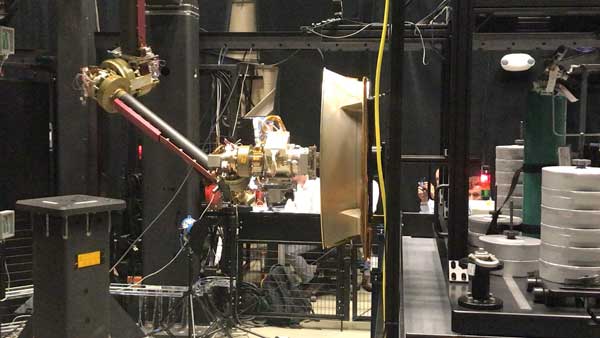
Simulating Space on Earth: NASA Receives Hardware for Testing Satellite Servicing Tech (Image Credit: SNN)

GREENBELT, Md. (NASA PR) — In August 2021, new testing equipment arrived at NASA’s Goddard Space Flight Center in Greenbelt, Maryland, in the form of a gravity offset table. NASA engineers will use the table to test robotic satellite servicing technologies that will one day operate in space.
A gravity offset table is a large piece of granite used for testing space payloads in simulated zero-gravity conditions. Measuring 8 feet by 10 feet and weighing 8.5 tons, the slab is polished precisely then leveled. A sled on top holds the test hardware. Three air bearings under the sled output a thin layer of air from a pressurized source allowing items to “float”, which simulates how a payload moves in space.
“It’s basically like an air hockey table in reverse,” said Joe Easley, robot operator group lead at NASA’s Exploration and In-Space Services Division at NASA Goddard. “For air hockey, a table perforated with jets of air floats a puck. In our system, it’s more like the puck, with the mass of a satellite, floats itself.”
To reach true zero-gravity, the table would need to simulate six degrees of freedom or directions in which objects can move. The gravity offset table has three degrees of freedom. It comes very close to zero-gravity – so close that you could push the payload with your finger, and it would glide away from you, just as it would in space.
NASA Goddard has been using this gravity offset technique for developing satellite servicing technologies since receiving its first gravity offset table in early 2017. It was and continues to be used for testing elements of the On-orbit Servicing, Assembly, and Manufacturing 1 (OSAM-1) mission, which will robotically refuel a satellite in space. This technique helps ensure that our complex simulations are accurate and realistic.
Simulating a space-like environment is critical to OSAM-1 testing. The technology demonstration mission will utilize a servicing spacecraft with two robotic arms that must match speed with and grapple a client satellite to refuel it. This is no easy feat since the client satellite was not designed to be grappled, and this operation must be fully autonomous. Reach too far and the servicer could push the satellite away; don’t reach far enough, and the servicer could miss the satellite. A gravity offset table allows NASA to test how a robot arm would interact with a satellite in space, which is mimicked by the payload on top of the sled.
OSAM-1 is managed by NASA Goddard and funded by NASA’s Space Technology Mission Directorate through its Technology Demonstration Missions program.
– Advertisement –





